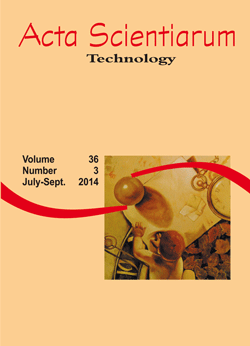<b>Evaluation of modulus of elasticity in static bending of particleboards manufactured with <i>Eucalyptus grandis</i> wood and oat hulls
DOI:
https://doi.org/10.4025/actascitechnol.v36i3.21077Palavras-chave:
particleboards, least squares method, recovery of waste, lignocellulosic particlesResumo
The aim of this study was to determine the modulus of elasticity (MOE) in static bending using two different calculation methods, a simple one based on Brazilian standard ABNT NBR 14810 (ABNT, 2006), and an alternative one, based on the Least Squares Method, and evaluate whether there is statistical equivalence between these MOE calculation methods. The alternative method employed results obtained from static bending tests at three-points, with three dial gauges, non-destructively, by imposing limits on two displacements (L 300-1 and L 200-1), where L is the specimen length. Results of confidence intervals indicated statistical equivalence between MOE values obtained by means of both methods, thus corroborating the simple mathematical model proposed by ABNT NBR14810 (ABNT, 2006). Panels produced with up to 15% oat hulls (Treatments 1 to 6) showed the highest average MOE values. The methods employed to obtain MOE in static bending were statistically equivalent. However, in addition to being non-destructive, the alternative method proposed here in provided more reliable results, just by taking into account more measures along the specimens.
Â
Downloads
Downloads
Publicado
Como Citar
Edição
Seção
Licença
DECLARAÇíO DE ORIGINALIDADE E DIREITOS AUTORAIS
Declaro que o presente artigo é original, não tendo sido submetido í publicação em qualquer outro periódico nacional ou internacional, quer seja em parte ou em sua totalidade.
Os direitos autorais pertencem exclusivamente aos autores. Os direitos de licenciamento utilizados pelo periódico é a licença Creative Commons Attribution 4.0 (CC BY 4.0): são permitidos o compartilhamento (cópia e distribuição do material em qualqer meio ou formato) e adaptação (remix, transformação e criação de material a partir do conteúdo assim licenciado para quaisquer fins, inclusive comerciais.
Recomenda-se a leitura desse link para maiores informações sobre o tema: fornecimento de créditos e referências de forma correta, entre outros detalhes cruciais para uso adequado do material licenciado.















